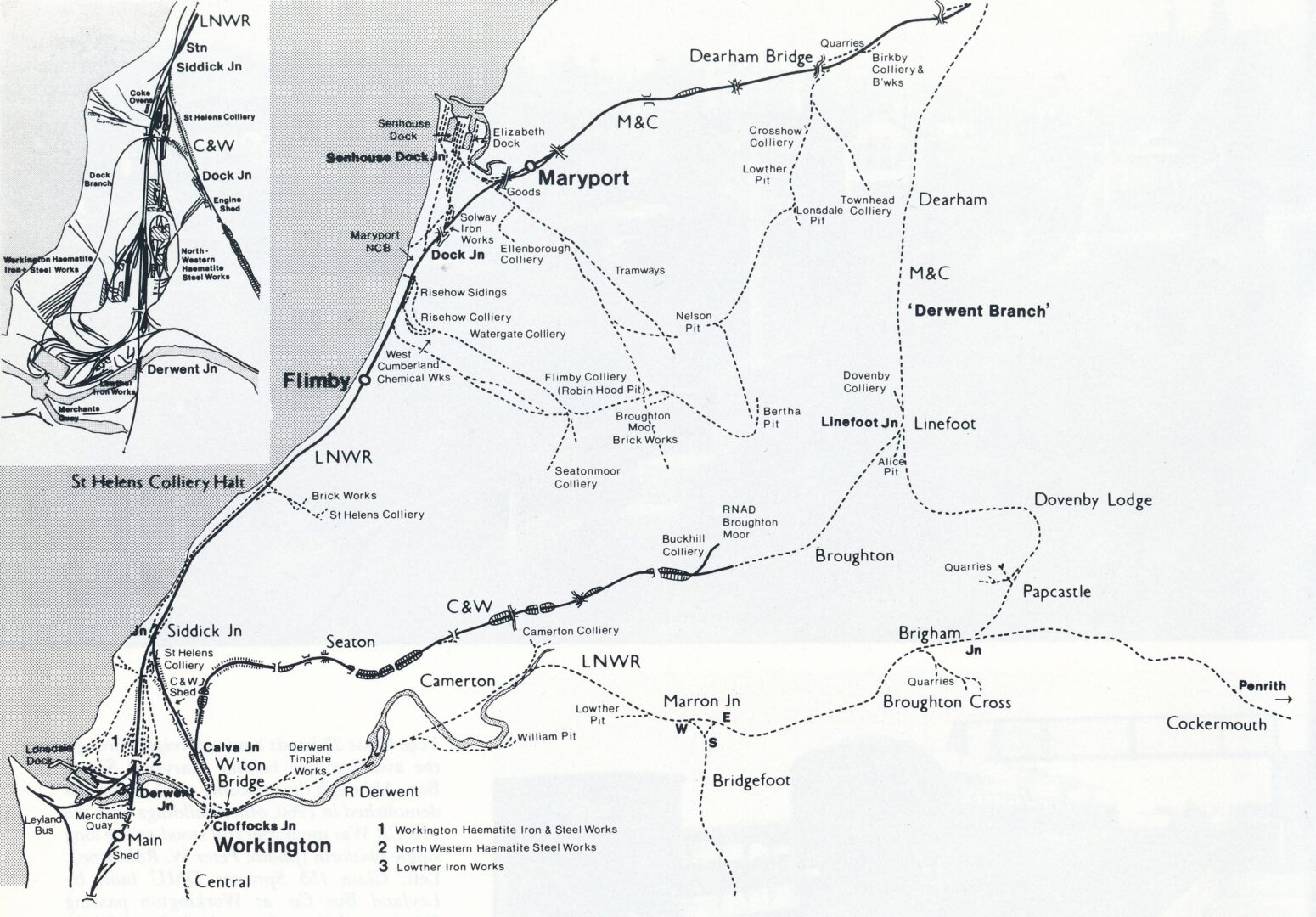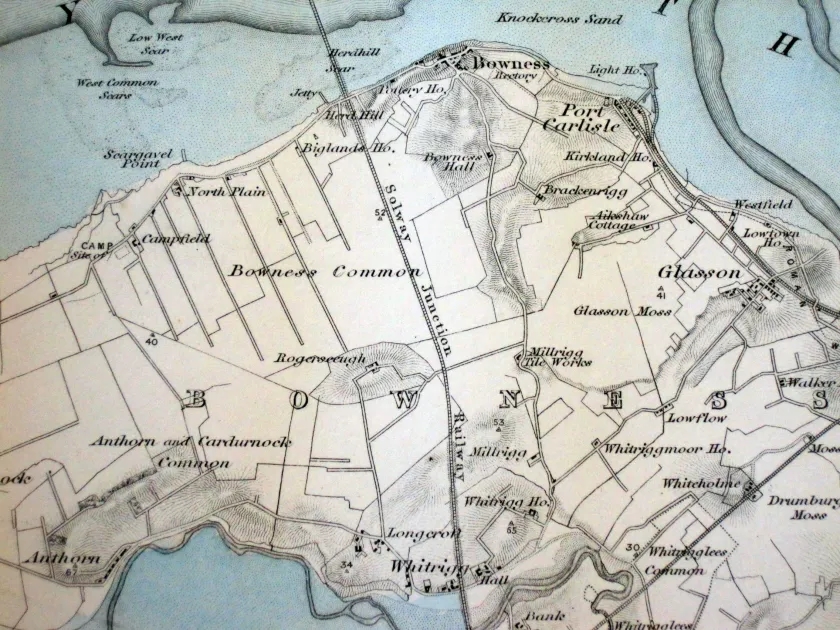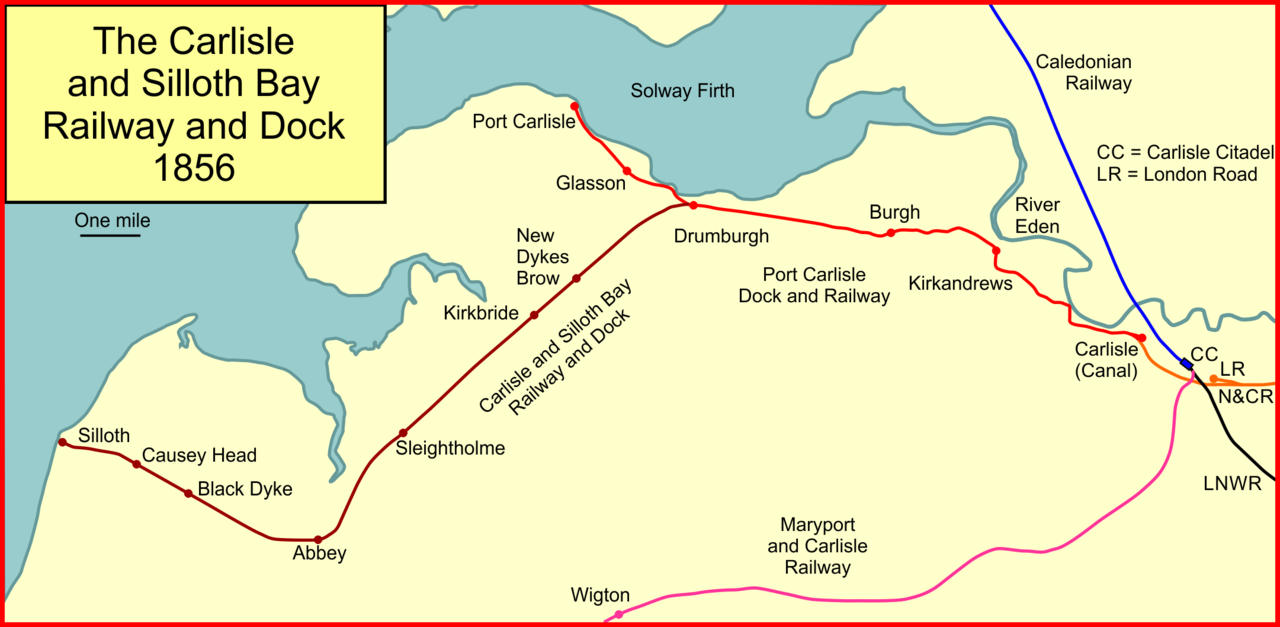Railway Routes in Cumberland
Table of Contents
Derwent Junction
The River Derwent powered an early ironworks at Seaton, close to the pit and its 1732 waggonway owned by Lord Lonsdale. A later Lonsdale was chairman of both the Whitehaven Junction and the Cockermouth and Workington Railways which joined here in 1847 to use Workington station. His waggonway crossing them to Merchants Quay became a formal railway in 1860 with the imminent completion of Lonsdale Dock.
The importance of Derwent Junction increased when the Cockermouth, Keswick & Penrith Railway linked with the Stainmore line to County Durham in 1864. CK&PR mineral trains were pulled by North Eastern locomotives, and other trains by London & North Western engines. The LNWR secured a hold on the district by absorbing both the Cockermouth & Workington and Whitehaven Junction companies in 1865.
The incentive was the vast increase in production of haematite iron following the successful experiments with low phosphorus pig iron from the Oldside Ironworks when Henry Bessemer first made steel in quantity.
The West Cumberland Haematite Iron & Steel Co opposite rolled the first steel rails at Workington in 1872. However, its innovative manager, George Snelus, helped develop the basic steel process that did not need local haematite.
The works closed in 1892, but Oldside survived to be in the United Steel Co. This opened the Prince of Wales dock nearby in 1927 which continued to need access at Derwent Junction after the closure of the route to Keswick in 1966.
The Port Carlisle branch
It was a common occurrence for canals to be bought up by railway companies, but rarely was the rail line actually laid in the bed of the canal as happened with this branch. The canal had been opened in 1823, linking Carlisle to the highest navigable point on the Solway Firth which could be reached by ships of up to 100 tons.
The canal was mostly for goods, but from 1833 a ferry operated between Port Carlisle and Liverpool, whose passengers included German and Polish emigrants bound for America. These had travelled on the Newcastle & Carlisle Railway, which opened a 11h-mile branch to the canal basin in Carlisle in 1837. Eight years later, the Maryport & Carlisle main line was completed, and Port Carlisle’s trade went into decline, leading to the closure of the canal in 1853.
As early as 1847 conversion to a railway had been discussed, and once the canal shut the Port Carlisle Dock & Railway Company was swiftly formed and only ten months later the first passenger train ran on 22nd June 1854, with no opening ceremony at all. ‘Scarcely more than a dozen’ people travelled on the first train, watched by a few spectators. Over thirty years earlier an estimated crowd of 26,400 had watched the first vessel arrive in Carlisle’s canal basin.
The new railway’s trains took 35 minutes for the 11 mile journey, starting at a short-lived Canal station at the Carlisle end, followed by Kirkandrews, Burgh (Burgh-bySands from 1923), Drumburgh and Glasson (which was always a request stop) before the terminus at Port Carlisle. However, the conversion did not mean the port was any more able to compete with Maryport, Workington and Whitehaven, and its owners were already looking at an alternative site at Silloth. This was to be reached by a new line from Drumburgh, and when this was speedily constructed and opened in 1856, the Drumburgh-Port Carlisle section became a backwater, though with rails instead of its former canal!
The line’s reduced status was soon emphasised by the most famous feature of its workings, the ‘Dandy’ service. This was a passenger coach hauled along the track between Drumburgh and Port Carlisle by a horse, a system that stayed in use for well over fifty years. It was introduced in 1857, although steam engines continued to handle the branch’s goods traffic up to 1898. By then the track was in such poor condition that only special freight could be handled, again by horse traction.
Four vehicles were used at various times on the passenger service, the most famous being ‘Dandy No I’, still in use in 1914 though built in 1861 and now at the National Railway Museum, York. Eventually the NBR, which finally absorbed the branch along with the Silloth line in 1880, decided to replace this anachronism. The first attempt to reintroduce steam traction in 1908 failed due to the poor standard of the track, but heavier rails were laid and six years later England’s last horse-hauled passenger service was at last replaced.
The final running of the ‘Dandy’ was on Saturday 4th April 1914, and two days later NBR class R 0-6-0T no 22 hauled the ‘first’ steam train of the new era. Crowds of people attended both events, and so many wanted to travel on the two-coach steam train that extra trips had to be made.
During the First World War the service was suspended between January 1917 and February 1919. When it resumed passengers had been lost to the local buses, and despite attempts to attract trippers from Carlisle, the trains were soon cut back to only two weekday return trips from Drumburgh. The LNER made a last try at boosting traffic with Sentinel railcars from Carlisle in 1928, and one of these, Flower of Yarrow, was the last passenger working to Port Carlisle on 31st May 1932. Goods services finished on the same day, and the line beyond Drumburgh was abandoned, although the original line from there to Carlisle stayed in use for the Silloth trains for another 32 years.
Little can be seen of the line in Carlisle, but its route through Kirkandrews and Burgh is marked by numerous cuttings, many denoting the line of the canal while from Dykesfield to Drumburgh the 2.5 mile embankment that carried both canal and railway can be walked. Kirkandrews and Burgh station buildings survive, though much altered, but nothing remains at the sites of Drumburgh and Glasson stations. Only a platform is left at Port Carlisle, and the lock entrance is all that remains of the harbour
The Silloth branch
Construction of this line began with great ceremony at Drumburgh on 31st August 1855. A gaily decorated engine had driven out from Carlisle, and Sir James Graham cut the first sod as the Warwick Band played God Save The Queen. Construction was rapid across the level Solway plain and a year later there was a second ceremony on 28th August 1856, when the company’s directors, the Mayor and Corporation of Carlisle, two bands and at least 1,500 passengers travelled on two special trains for the line’s opening, which was followed by a dinner for 350 guests in a tent by the newly constructed hoteL
Almost everything at Silloth was’ new’ as before the railway came there were only a few hamlets and scattered farms in the area. It had been chosen as the site of the Solway coast’s first wet dock in 1852, when the Carlisle & Silloth Bay Dock & Railway Company was formed. In fact the dock was not opened until 1859, by which time the Newcastle & Carlisle had agreed with the NER to route its East-West freight via York and Liverpool rather than Carlisle. Thus much of Silloth’s potential trade was lost from the start; instead hopes were pinned on a takeover by the NBR and the development of tourism at Silloth. For this the company had purchased nearly 200 acres of land for a town, where it had built a hotel at a cost of over £7,000, and overseen the construction of public baths, lodging houses, residences, gasworks and a sewerage system, a11 without any authorisation.
All this left the company on the verge of bankruptcy, and in 1859 it and the Port Carlisle line were leased to the NBR. The latter introduced steamship services to Ireland and Liverpool, and improved the port facilities. Meanwhile the passenger services continued, with four or five daily trains each way, which were only well used in summer. There was little traffic from the intermediate stations at Kirkbride, Abbey (Abbey Town from 1889t Abbeyholme, which became Abbey Junction with the opening of the Solway Junction line to passengers in 1870, and Black Dykes (Blackdyke Halt from 1921).
The NBR tried to develop other traffic, for example building a halt for Silloth Convalescent Home on the Bliterlees branch from the terminus. In 1886 this was extended to the Silloth Battery, built by Armstrong Whitworth for testing heavy guns and in use until 1926. Passenger specials were run for the visits of military leaders, including at least one Royal Visit. There were many incoming excursions, especially from Carlisle in the summer, and also outgoing ones to agricultural events such as the Westmorland Show at Kendal in 1897 when 34 coaches were needed. Seven years previously, keen to promote its own achievements, the NBR had run five special trains from the branch for the opening of the Forth Railway Bridge.
The line continued to be busy with summer visitors, and freight to and from the port. The remaining passenger sailings to Liverpool, Ireland and the Isle of Man virtually ended during the First World War, and Abbey Junction station closed in 1921. Little changed under the LNER; the line and port were particularly busy during the Second World War. However, after 1945 the line went into decline, with lack of maintenance and loss of freight. Drumburgh station closed in 1955, but passenger numbers to Silloth could still be significant, with, for example, over 3,000 visitors by rail on Whit Monday 1963.
However, the Beeching Report claimed the line was losing £23,500 a year, and recommended closure. Despite the findings of a TUCC hearing and an 8,000 strong petition, the end for goods services was scheduled for 1st June 1964 and for passenger trains three months later. There was not to be a handful of locals and enthusiasts to see the last train, instead on Saturday 5th September a crowd of over 1,000 people packed the terminus amidst scenes uncommon for a British railway closure.
The last day trains were not the usual two-car DMU set, introduced in 1954, but comprised eight coaches, hauled by a diesel loco for the 11.35 am and 6 pm departures from Silloth, but then for the final one, scheduled for 7.58 pm, by class 4 2-6-0 no 43139, known as Jezebel at Carlisle’s Kingsmoor shed. This train was at first unable to reach the platform at Silloth due to demonstrators sitting on the track. When these were moved, and four extra coaches added for the return journey, the same happened again until the line was cleared by railway police. Even then there was a further delay for a bomb hoax before the train reached Carlisle where the passengers were herded away by police for fear of further trouble.
After such a dramatic finale, the track was speedily removed and now there is little left, although Kirkbride, Abbey Town and Black Dykes station houses remain as residences. Silloth station building, though much altered, survived until 2007 and was then demolished, though the port and seaside resort are still there as reminders of a failed railway enterprise.
See Carlisle & Silloth Railway at Cumbria-Railways.co.uk
Map below by Afterbrunel – Own work, CC BY-SA 4.0, https://commons.wikimedia.org/w/index.php?curid=41923861
Risehow siding/Flimby Station
Early waggonways from the Lonsdale Collieries on Broughton Moor were linked to the Whitehaven Junction Railway at Flimby when it opened in 1847. Then in 1859 it built a direct line into Maryport Docks from a junction at Risehow.
Here in 1871 the Solway Haematite Iron Co built blast furnaces close to those of the Maryport Haematite Iron Co. Similar developments close to the Cumberland ore field used the haematite ore that the Solway Junction Railway had hoped to carry to Scotland.
Between Flimby and Maryport. In Flimby woods the walls of part of the winding gear of the overhead ropeway can still be seen in 2022. The map on page 22 names the place Robin Hood Pit and it is adjacent to Broughton Moor Brick Works.
Durham coke was used until 1908, when forty Koppers coke ovens were built at Risehow. Although the ironworks closed in 1927, coal was carried by the Risehow tramway until 1968. Open cast workings on Broughton Moor then sent coal by road to Maryport Washery. In 1981 a merrygo- round train loading point was built at the former Dock Junction site to load 1,500 tonne trains for power stations at Roosecote, Fiddlers Ferry and then Rugeley.
The main line along the shore past Flimby was severely damaged in storms in 1977 when a mile of track was lifted 50ft inland!
Siddick Junction
The tracks diverging inland were the last strand in a network linking iron and coal mines, coke ovens and limestone quarries to the iron and steel works that used their products.
To break the existing railway cartel, the Cumberland ironmasters opened this, their own line, the Cleator & Workington Junction Railway in 1879. Its own O-6-OSTs based at Central shed handled mineral trains. Furness Railway locomotives worked passenger services as far north as Siddick Junction from their shed at Dock Junction. So much mineral traffic had to be moved during the Great War that trains were coupled together with locomotives in front, in the middle and the rear!
All passenger traffic stopped in 1930, but the construction of the Royal Naval Armaments Depot at Broughton Moor [RNAD] in 1940 saved part of the Northern Extension which had earlier closed beyond Buckhill Colliery to Linefoot Junction in 1921. Following closure of the C&WJR main line from the south in 1965, trains for the RNAD had to reverse at Calva Junction.
Text with my own additional notes From Rails round the Cumbrian Coast by Richard Kirkman and Peter van Zeller Page 23 ISBN 0 85206 938 3 Dalesman Books 1988
For more read the book “Lost Railways of Cumbria by Gordon Suggitt, Countryside Books 3 Catherine Road Newbury Berkshire ISBN 978 1 84674 107 4 published through mrm Assooc Ltd Reading



